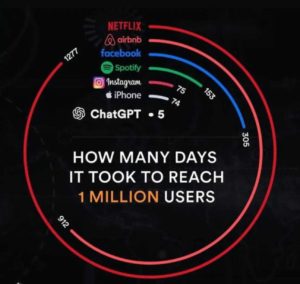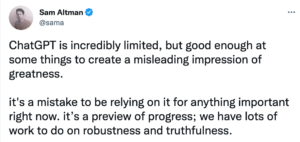
But for close followers of Large Language Models (LLMs), the renewed debate of what it is and isn’t capable of is nothing new. This is especially true for contact centers.
As one of the first industries to apply chatbots in a consumer setting, contact centers have always kept a keen eye on AI’s progress. The advent of comprehensive solutions like Contact Center Automation has only boosted that interest in recent years.
So, after ChatGPT’s latest quantum leap in Large Language Models, what should contact centers know this time around?
What it doesn’t mean
LLMs have not reached near-perfect accuracy
ChatCPT is a mind-bending display of computational power. But it is far from perfect. As the largest scale generative AI to date, ChatGPT’s input is essentially the entire internet. This gives it the ability to accurately infer most questions correctly and generate a reply to each question. However, while this scale means that answers will almost always be conversational, ChatGPT is not always reliable. ChatGPT will quite often answer questions inaccurately, inconsistently or illogically. From OpenAI’s own disclaimer: “we do not warrant that the services will be uninterrupted, accurate or error free, or that any content will be secure or not lost or altered.”
It can’t be unleashed in customer service
The accuracy risks of ChatGPT are not the only reason it’s far from customer service relevant. Notwithstanding the ethical and legal hurdles that remain to be cleared, one of the biggest limitations of ChatGPT is the fact that answering questions and resolving customer issues are two very different things. In order to resolve customer requests, automation requires a few elements: understanding the workflows of an organization; access to internal systems to perform requested actions (like booking a flight or requesting roadside assistance); and, security and compliance so PII and sensitive data are never at risk. None of these features are part of ChatGPT right now. In addition, the customer service environment is one where patience can quickly run thin, and urgent requests must be escalated to agents quickly. Contact centers require solutions that don’t exist to simply converse, but provide customers with end-to-end resolution at every step.

Sam Altman, CEO of OpenAI
Agent jobs are not at risk
Neither Large Language Models nor Contact Center Automation can replace the creativity and empathy that live agents provide. However, both can help an employee group that has experienced massive pressure in recent years. Contact centers can leverage ChatGPT as a tool for their agents to write new scripts, brainstorm responses, and even write simple replies. Contact Center Automation, an AI solution trained specifically for customer service, can go beyond that to fully resolve any amount of customer requests with high accuracy and 24/7 availability. Agents, who often spend hours on end on repetitive requests, benefit the most from tools that free them up to focus on more high-value requests.
What it does mean
AI has become mainstream
The field of AI can be traced back to the 1950s. The first examples of conversational computers followed soon after. Over the past few decades, AI has come to life in the public sphere mostly as clunky chatbots or laggy voice assistants. ChatGPT represents another step forward in AI becoming a household technology. It signals growing demand from customers for voice and chat assistants that truly allow them to speak naturally. This reflects the findings of the 2022 Benchmark Report, which found that most contact center leaders (95%) are prioritizing automation in part due to customers’ growing willingness to interact with an efficient machine.
CX should reflect the state of technology
The fact that ChatGPT has launched AI into the mainstream is in many ways a direct call to action for customer service organizations. Now more than ever, almost every consumer is acutely aware of the capabilities of automation. They can quickly pick up on the differences between an IVR that is trying to deflect them and an AI-powered solution that can actually help them. On top of that, 72% of customers are likely to share their positive experiences with six other customers, whereas one in three customers will leave a brand entirely after one bad experience. For contact centers, this means the time is now to begin automating – at the very least to avoid your competitors from beating you to the punch.
Contact Center Automation will only get better
ChatGPT has raised the bar for AI. While it may not be suitable for direct use in contact centers, the solution will raise the tide for almost every existing AI solution. In the case of Contact Center Automation, ChatGPT has many useful applications. It can help engineers feed a larger scale of utterances into their own models as a powerful conversational AI training tool. It can serve as a model for summarizing call notes more efficiently so agents spend less time catching up during escalations. Industry-wide, ChatGPT has shown that automation is not only the future, but that the future is closer than many think. For contact centers, this means the sooner automation becomes a part of your gameplan the better.
 First Notice of Loss
First Notice of Loss 




